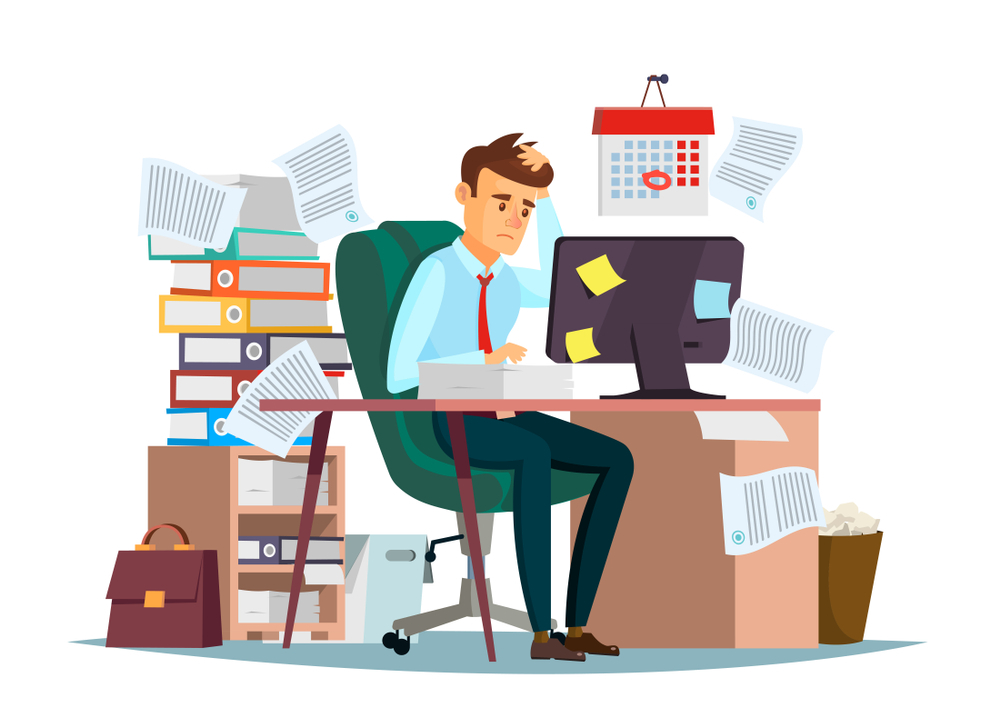
- 1. Spinal rotation while seated
- 2. Shoulder stretch (posterior)
- 3. Shrugs on the shoulders
- 4. Extensions of the sitting back
- 5. Rotations of the neck
- 6. Neck and upper shoulder stretches
- 7. Shoulder extension – this is one of the most common exercises.
- 8. Two shoulder extensions
- Also, do you have a comfortable seat?
- Make sure your posture is perfect.
- What should I look for in a posture corrector?
Exercises For Desk Job Workers- Modern technology has provided us with many benefits and conveniences, but there is one huge drawback: most of us spend eight (or more) hours a day, five days a week, for the majority of the year sitting at a desk.
Sadly, the same thing that makes us busy, profitable, and successful employees for our organization can also destroy our health—possibly permanently.
Risk Factors From Too Much Sitting:
Weight gain, heart disease, diabetes, high blood pressure, and other chronic illnesses can all be linked to too much sitting. People who sit all day have a 40% increased risk of dying, according to one (somewhat disturbing) study.
While we aren’t claiming that your job will kill you, it is a good idea to take some basic steps to improve your workplace health. Simply start moving your body a little more at your desk as a simple place to start.
The good news is that moving or stretching is a habit that can be developed. To begin, set a timer to remind yourself to go for a little stroll or stretch. There are even some stretches you can do at your desk if you’re short on time. Scroll down for a guide on how to get those computer bugs worked out.
Always remember to breathe properly and never hold your breath during the stretches. You can find yourself becoming more flexible with each stretch. Don’t go any further than you’re comfortable with.
Exercises For Desk Job Workers :
1. Spinal rotation while seated
- Cross your arms over your chest while seated.
- Take your shoulders in your hands.
- Turn your upper body from the waist, as far as it feels comfortable, from left to right.
– As your lower back expands out, you should feel tightness on both sides.
2. Shoulder stretch (posterior)
- One arm should be crossed across your torso.
- Grasp your elbow and pull it into your chest.
- You should be able to feel your shoulder stretching.
3. Shrugs on the shoulders
- Raise your shoulders gently.
- Allow them to fall naturally.
- As your shoulders drop, you should notice a relief of tension.
4. Extensions of the sitting back
- Sit with your feet together and your back straight.
- Place your palms against the small of your back.
- Feel your lower back stretch out as you lean back over your hands.
5. Rotations of the neck
- Maintain a straight line of sight.
- Turn your head from side to side gently.
- Try to move your head past your shoulder as you spin it.
- The muscles on the outside of your neck should be gradually stretching.
6. Neck and upper shoulder stretches
- Sit with one hand on the table.
- Tilt your head away from the hand on which you’re seated.
- Slightly tilt your head forward, towards your shoulder.
- The muscles in your neck and shoulder should feel stretched.
- Repeat on the other side.
7. Shoulder extension – this is one of the most common exercises.
- Stretch your arms behind you as you stand up.
- Lift your arms gently by clasping your hands together.
- Your shoulders and chest should be stretching.
8. Two shoulder extensions
- Both arms should be held above your head.
- Your palms should be facing upwards as you join your hands.
- As high as you possibly can.
- Your shoulders should be able to stretch.
Also, do you have a comfortable seat?
Stretching at your desk is beneficial, but being comfortable at your workstation is much more vital. This, among other things, can help to prevent back pain. Here’s a gentle nudge in the right direction.
- Maintain a close proximity between your chair and your workstation.
- Make sure your feet are fully on the floor by adjusting the height.
- Your computer screen’s top should be level with your eyes and about an arm’s length away.
Make sure your posture is perfect.
- Hips should be higher than knees.
- Sit back in your chair so that your entire back is supported.
- Your lower back’s natural curve should match the curve of the backrest.
- Slightly recline the back rest (10–15 degrees).
- Keep your elbows at 90 degrees, slightly above the desk, and relax your shoulders.
What should I look for in a posture corrector?
Here are some of the most popular devices and styles on the market, so you can pick the best fit for your needs and lifestyle.
1. Support Brace for Clavicle, Chest, and Back
These posture correctors are basic and easy to use—not to mention, easy to find. You may be able to get one from your physical therapist’s office, or you can search on Amazon to find options (like the one to the right!).
It wraps over your upper back after being slipped on over your shoulders. It’s almost as if you’re wearing a backward bra. This is beneficial since the gadget helps to counterbalance the effect of your breasts pulling your chest and front side forward.
2. Posture Corrector with Two Straps
This back brace incorporates a waist strap and an elastic belt to provide extra lumbar support and comfort while wearing it. The cushioned back strip also contains two auxiliary support bars for increased structure. “I put it on for the first time and my 9 years old entered the room a minute later and said I had grown taller somehow,” one Amazon reviewer wrote.
3. Eivotor Posture Corrector Trainer
This smart posture corrector is made of an ergonomic elastic and nylon material that fits over your shoulders. It also comes with a sensor that vibrates when your posture is out of alignment to help you establish muscle memory and develop a habit of straightening with a gentle reminder.
“The ‘out of posture’ vibration is significant and definitely draws your attention to straighten up,” one Amazon reviewer said. It works fantastically!!”
4. GO Electronic Posture Trainer (Upright)
If all you need is a subtle reminder when you’re slouching, Smith suggests trying one of the wearable devices.
These adhere to the front of your bra with a clip or to the skin on your upper back with adhesive and vibrate when your posture starts to sag. Some also come with a phone app that allows you to track your metrics over time.
Keep in mind that these are more expensive than traditional braces and require charging or batteries, but they are virtually undetectable under clothing. If you want a posture reminder throughout the day but don’t want to spend the money, you can configure your watch to alert you at predetermined intervals.
Set a smartphone alarm for every hour to remind you to check your posture and take a break to stand, walk, and stretch. “One of the biggest causes of back discomfort is our sedentary lifestyle, and the best thing you can do is get more motion,”
5. Upper Back Brace That Can Be Adjusted
This seamless back brace also targets the upper back and has adjustable straps for a personalized fit.
It also comes with a drawstring bag in which to store it.
“Rather than pushing me to sit up, it acts as a constant reminder, which is as effective. One Amazon reviewer remarked, “The straps are lovely and durable.”
6. Back Brace with Magnets
Many popular brace models claim to contain pain-relieving magnets carefully placed within them. While that may seem unlikely, magnet-enabled braces are not detrimental if you enjoy the way they feel (some reviewers say the weight of the magnets feels relaxing or soothing).
7. Strong Support Brace
This brace is ideal for those who require additional support. It’s held in place by two large steel support plates curved along the spine and covering the entire back. After wearing it for a few minutes, one Amazon reviewer reported they felt “comfort within minutes.”
Also Read: How To Get Rid Of Acne- Everything You Should Know – V Cure (vcurehealthcare.com)





